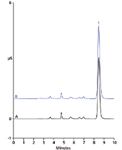Accurate Determination of Tartrate in Drug Products in Just 10 Minutes
Tolterodine, a quaternary ammonium compound, is used to treat urinary incontinence. To create the drug substance, tolterodine is paired with tartrate to form tolterodine tartrate. This drug substance can then be used to create drug products. One way to confirm the amount of a drug substance in a drug product is to assay for its counterion.
Tolterodine, a quaternary ammonium compound, is used to treat urinary incontinence. To create the drug substance, tolterodine is paired with tartrate to form tolterodine tartrate. This drug substance can then be used to create drug products. One way to confirm the amount of a drug substance in a drug product is to assay for its counterion. This is especially true for counterions such as tartrate that are unlikely to originate from any other sample components. Ion chromatography (IC) with suppressed conductivity detection is a common technique for counterion determinations. Here we report an IC method to determine tartrate in a tolterodine tartrate drug product that is faster, requires less labor, and eliminates analyst exposure to strong acid relative to a recently published IC method (1).
Equipment
A Thermo Scientific Dionex ICS-5000 IC System configured with an EG Eluent Generator module, DC Detector/Chromatography Compartment, and CD Conductivity Detector was used. Samples were introduced by an AS-AP Autosampler. All data collection and processing was controlled by Thermo Scientific Dionex Chromeleon Chromatography Data System software. Complete experimental details are found in reference 2.
Results
Figure 1 Trace A shows the determination of tartrate in a capsule drug product containing tolterodine tartrate. Tartrate is resolved from other anions in the sample using a Thermo Scientific Dionex IonPac AS20 Hydroxide-Selective Anion-Exchange Column set with 20 mM potassium hydroxide. The eluent is produced by the eluent generator, and therefore the labor and possible error associated with eluent preparation are eliminated. Tartrate is detected by suppressed conductivity in the recycle mode, indicating that the analyst does not have to prepare a strong acid solution for suppressed conductivity detection. Figure 1 Trace B shows the same sample to which an additional 4 mg/L tartrate was added. For a set of five samples there was 100% recovery of the added tartrate. The same unfortified five samples had 98.4% of the labeled amount of drug substance as measured by tartrate concentration. Both results indicate good method accuracy. Overall this is an accurate IC method for determining tartrate that does not require the analyst to prepare eluent or strong acid regenerant.

Figure 1: Determination of tartrate in a drug capsule: Trace A shows the sample and Trace B is the sample to which 4 mg/L tartrate was added before sample preparation.
References
(1) G.R. Deshpande, B.M. Rao, and N. Someswararao, "Quantitative Determination of Tartaric Acid in Tolterodine Tartrate by Ion Chromatography Using Conductivity Detection," RASAYAN J. Chem., 2101–2107 (2009).
(2) Thermo Scientific Application Note 1002: Determination of Tartaric Acid in Tolterodine Tartrate Drug Products by IC with Suppressed Conductivity Detection, Sunnyvale, CA, 2012. [Online] http://www.dionex.com/en-us/webdocs/113488-AN1002-IC-TartaricAcid-TolterodineTartrate-02May2012-LPN3065.pdf (accessed May 31, 2012).
Receive the complete application note at: www.thermoscientific/AN1002
Thermo Fisher Scientific Inc.
1228 Titan Way, P.O. Box 3603, Sunnyvale, CA 94088-3603,
tel. (800) 532-4752
Website: www.thermoscientific.com/dionex

SEC-MALS of Antibody Therapeutics—A Robust Method for In-Depth Sample Characterization
June 1st 2022Monoclonal antibodies (mAbs) are effective therapeutics for cancers, auto-immune diseases, viral infections, and other diseases. Recent developments in antibody therapeutics aim to add more specific binding regions (bi- and multi-specificity) to increase their effectiveness and/or to downsize the molecule to the specific binding regions (for example, scFv or Fab fragment) to achieve better penetration of the tissue. As the molecule gets more complex, the possible high and low molecular weight (H/LMW) impurities become more complex, too. In order to accurately analyze the various species, more advanced detection than ultraviolet (UV) is required to characterize a mAb sample.















